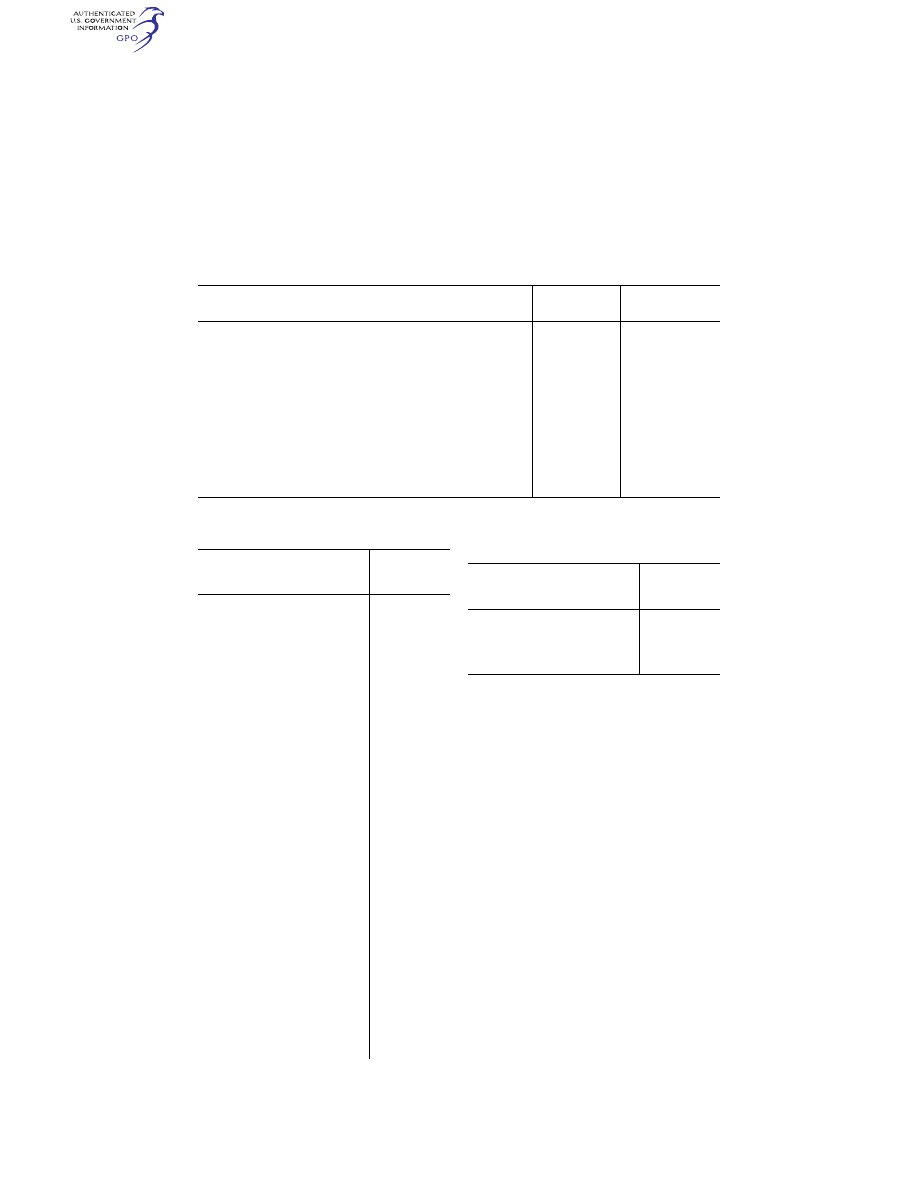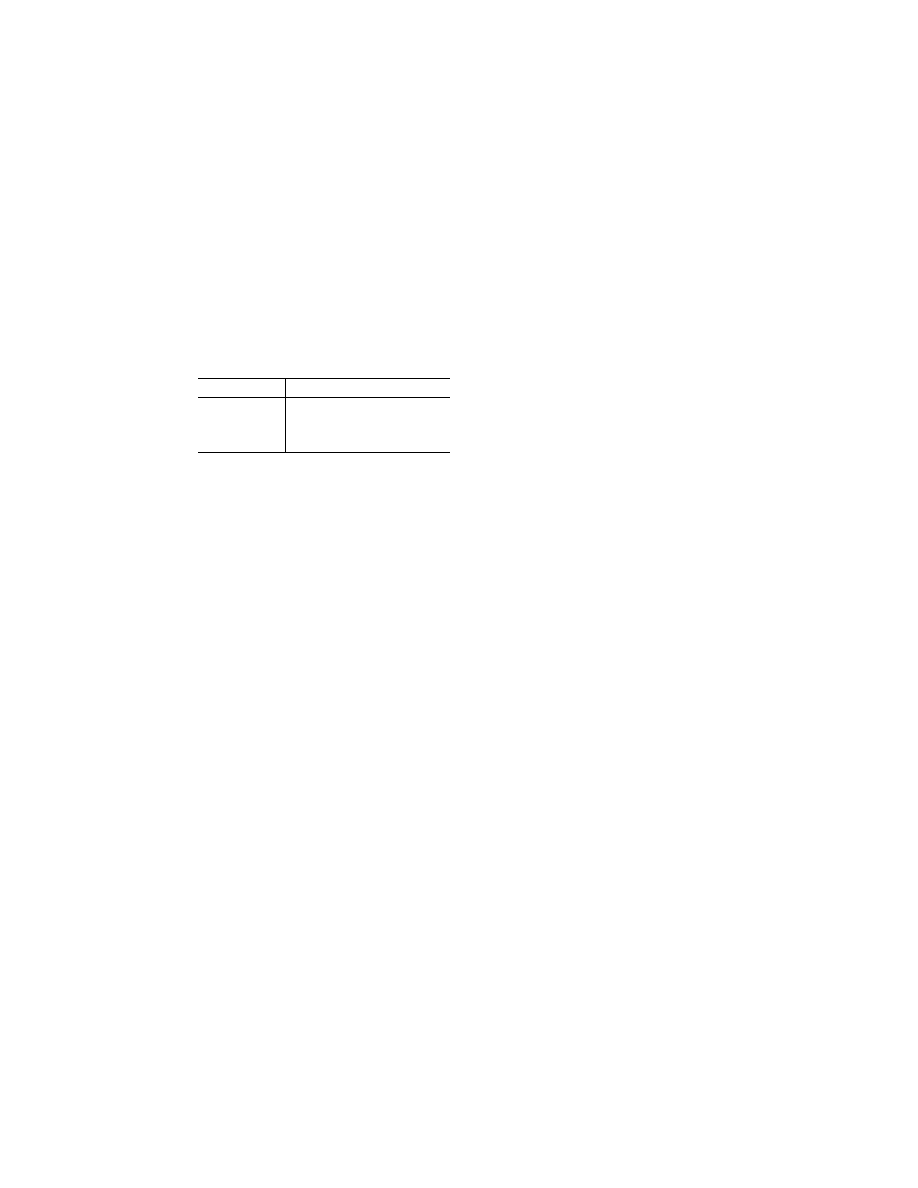
266
14 CFR Ch. I (1–1–24 Edition)
§ 121.1117
T
ABLE
1—A
IRPLANES
S
UBJECT TO
§ 26.21—Continued
Airplane model
Compliance date—
months after Janu-
ary 14, 2011
Default LOV
[flight cycles (FC)
or flight hours (FH)]
All airplanes whose maximum takeoff gross weight has been decreased
to 75,000 pounds or below after January 14, 2011, or increased to
greater than 75,000 pounds at any time by an amended type certifi-
cate or supplemental type certificate.
30, or within 12
months after the
LOV is ap-
proved, or be-
fore operating
the airplane,
whichever oc-
curs latest.
Not applicable.
All Other Airplane Models (TCs and amended TCs) not Listed in Table 2 .............
72, or within 12
months after the
LOV is ap-
proved, or be-
fore operating
the airplane,
whichever oc-
curs latest.
Not applicable.
1
Type certificated as of January 14, 2011.
Note: Airplane operation limitation is stated in the Airworthiness Limitation section.
T
ABLE
2—A
IRPLANES
E
XCLUDED
F
ROM
§ 26.21
Airplane model
Default LOV
[flight cycles (FC)
or flight hours
(FH)]
Airbus:
Caravelle ...................................
15,000 FC/24,000
FH
Avions Marcel Dassault:
Breguet Aviation Mercure 100C
20,000 FC/16,000
FH
Boeing:
Boeing 707 (–100 Series and
–200 Series) ..........................
20,000 FC
Boeing 707 (–300 Series and
–400 Series) ..........................
20,000 FC
Boeing 720 ................................
30,000 FC
Bombardier:
CL–44D4 and CL–44J ..............
20,000 FC
BD–700 .....................................
15,000 FC
Bristol Aeroplane Company:
Britannia 305 .............................
10,000 FC
British Aerospace Airbus, Ltd.:
BAC 1–11 (all models) ..............
85,000 FC
British Aerospace (Commercial Aircraft)
Ltd.:
Armstrong Whitworth Argosy
A.W. 650 Series 101 .............
20,000 FC
BAE Systems (Operations) Ltd.:
BAe 146–100A (all models) ......
50,000 FC
BAe 146–200–07 ......................
50,000 FC
BAe 146–200–07 Dev ...............
50,000 FC
BAe 146–200–11 ......................
50,000 FC
BAe 146–200–07A ....................
47,000 FC
BAe 146–200–11 Dev ...............
43,000 FC
BAe 146–300 (all models) ........
40,000 FC
Avro 146–RJ70A (all models) ...
40,000 FC
Avro 146–RJ85A and 146–
RJ100A (all models) ..............
50,000 FC
D & R Nevada, LLC:
Convair Model 22 ......................
1,000 FC/1,000
FH
Convair Model 23M ...................
1,000 FC/1,000
FH
deHavilland Aircraft Company, Ltd.:
D.H. 106 Comet 4C ..................
8,000 FH
Gulfstream:
GV .............................................
40,000 FH
GV–SP ......................................
40,000 FH
T
ABLE
2—A
IRPLANES
E
XCLUDED
F
ROM
§ 26.21—Continued
Airplane model
Default LOV
[flight cycles (FC)
or flight hours
(FH)]
Ilyushin Aviation Complex:
IL–96T .......................................
10,000 FC/30,000
FH
Lockhead:
300–50A01(USAF C 141A) .......
20,000 FC
[Doc. No. FAA–2006–24281, 75 FR 69785, Nov.
15, 2010, as amended by Amdt. 121–360, 77 FR
30878, May 24, 2012; Admt. 121–360A, 77 FR
55105, Sept. 7, 2012; Doc. No. FAA–2022–1355;
Amdt. 121–387, 87 FR 75847, Dec. 9, 2022]
§ 121.1117 Flammability reduction
means.
(a)
Applicability.
Except as provided
in paragraph (o) of this section, this
section applies to transport category,
turbine-powered airplanes with a type
certificate issued after January 1, 1958,
that, as a result of original type cer-
tification or later increase in capacity
have:
(1) A maximum type-certificated pas-
senger capacity of 30 or more, or
(2) A maximum payload capacity of
7,500 pounds or more.
(b)
New Production Airplanes.
Except
in accordance with § 121.628, no certifi-
cate holder may operate an airplane
identified in Table 1 of this section (in-
cluding all-cargo airplanes) for which
the State of Manufacture issued the
original certificate of airworthiness or

267
Federal Aviation Administration, DOT
§ 121.1117
export airworthiness approval after De-
cember 27, 2010 unless an Ignition Miti-
gation Means (IMM) or Flammability
Reduction Means (FRM) meeting the
requirements of § 26.33 of this chapter is
operational.
T
ABLE
1
Model—Boeing
Model—Airbus
747 Series
A318, A319, A320, A321 Series
737 Series
A330, A340 Series
777 Series
767 Series
(c)
Auxiliary Fuel Tanks.
After the ap-
plicable date stated in paragraph (e) of
this section, no certificate holder may
operate any airplane subject to § 26.33
of this chapter that has an Auxiliary
Fuel Tank installed pursuant to a field
approval, unless the following require-
ments are met:
(1) The certificate holder complies
with 14 CFR 26.35 by the applicable
date stated in that section.
(2) The certificate holder installs
Flammability Impact Mitigation
Means (FIMM), if applicable, that is
approved by the responsible Aircraft
Certification Service office.
(3) Except in accordance with
§ 121.628, the FIMM, if applicable, is
operational.
(d)
Retrofit.
Except as provided in
paragraphs (j), (k), and (l) of this sec-
tion, after the dates specified in para-
graph (e) of this section, no certificate
holder may operate an airplane to
which this section applies unless the
requirements of paragraphs (d)(1) and
(d)(2) of this section are met.
(1) IMM, FRM or FIMM, if required
by §§ 26.33, 26.35, or 26.37 of this chapter,
that are approved by the responsible
Aircraft Certification Service office,
are installed within the compliance
times specified in paragraph (e) of this
section.
(2) Except in accordance with
§ 121.628, the IMM, FRM or FIMM, as
applicable, are operational.
(e)
Compliance Times.
Except as pro-
vided in paragraphs (k) and (l) of this
section, the installations required by
paragraph (d) of this section must be
accomplished no later than the appli-
cable dates specified in paragraph
(e)(1), (e)(2), or (e)(3) of this section.
(1) Fifty percent of each certificate
holder’s fleet identified in paragraph
(d)(1) of this section must be modified
no later than December 26, 2014.
(2) One hundred percent of each cer-
tificate holder’s fleet identified in
paragraph (d)(1) of this section must be
modified no later than December 26,
2017.
(3) For those certificate holders that
have only one airplane of a model iden-
tified in Table 1 of this section, the air-
plane must be modified no later than
December 26, 2017.
(f)
Compliance After Installation.
Ex-
cept in accordance with § 121.628, no
certificate holder may—
(1) Operate an airplane on which IMM
or FRM has been installed before the
dates specified in paragraph (e) of this
section unless the IMM or FRM is oper-
ational, or
(2) Deactivate or remove an IMM or
FRM once installed unless it is re-
placed by a means that complies with
paragraph (d) of this section.
(g)
Maintenance Program Revisions.
No
certificate holder may operate an air-
plane for which airworthiness limita-
tions have been approved by the re-
sponsible Aircraft Certification Service
office in accordance with §§ 26.33, 26.35,
or 26.37 of this chapter after the air-
plane is modified in accordance with
paragraph (d) of this section unless the
maintenance program for that airplane
is revised to include those applicable
airworthiness limitations.
(h) After the maintenance program is
revised as required by paragraph (g) of
this section, before returning an air-
plane to service after any alteration
for which airworthiness limitations are
required by §§ 25.981, 26.33, or 26.37 of
this chapter, the certificate holder
must revise the maintenance program
for the airplane to include those air-
worthiness limitations.
(i) The maintenance program
changes identified in paragraphs (g)
and (h) of this section must be sub-
mitted to the operator’s Principal
Maintenance Inspector responsible for
review and approval prior to incorpora-
tion.
(j) The requirements of paragraph (d)
of this section do not apply to air-
planes operated in all-cargo service,

268
14 CFR Ch. I (1–1–24 Edition)
§ 121.1119
but those airplanes are subject to para-
graph (f) of this section.
(k) The compliance dates specified in
paragraph (e) of this section may be ex-
tended by one year, provided that—
(1) No later than March 26, 2009, the
certificate holder notifies its respon-
sible Flight Standards office or Prin-
cipal Inspector that it intends to com-
ply with this paragraph;
(2) No later than June 24, 2009, the
certificate holder applies for an amend-
ment to its operations specification in
accordance with § 119.51 of this chapter
and revises the manual required by
§ 121.133 to include a requirement for
the airplane models specified in Table 2
of this section to use ground air condi-
tioning systems for actual gate times
of more than 30 minutes, when avail-
able at the gate and operational, when-
ever the ambient temperature exceeds
60 degrees Fahrenheit; and
(3) Thereafter, the certificate holder
uses ground air conditioning systems
as described in paragraph (k)(2) of this
section on each airplane subject to the
extension.
T
ABLE
2
Model—Boeing
Model—Airbus
747 Series
A318, A319, A320, A321 Series
737 Series
A300, A310 Series
777 Series
A330, A340 Series
767 Series
757 Series
(l) For any certificate holder for
which the operating certificate is
issued after December 26, 2008, the com-
pliance date specified in paragraph (e)
of this section may be extended by one
year, provided that the certificate
holder meets the requirements of para-
graph (k)(2) of this section when its ini-
tial operations specifications are
issued and, thereafter, uses ground air
conditioning systems as described in
paragraph (k)(2) of this section on each
airplane subject to the extension.
(m) After the date by which any per-
son is required by this section to mod-
ify 100 percent of the affected fleet, no
certificate holder may operate in pas-
senger service any airplane model spec-
ified in Table 2 of this section unless
the airplane has been modified to com-
ply with § 26.33(c) of this chapter.
(n) No certificate holder may operate
any airplane on which an auxiliary fuel
tank is installed after December 26,
2017 unless the FAA has certified the
tank as compliant with § 25.981 of this
chapter, in effect on December 26, 2008.
(o)
Exclusions.
The requirements of
this section do not apply to the fol-
lowing airplane models:
(1) Convair CV–240, 340, 440, including
turbine powered conversions.
(2) Lockheed L–188 Electra.
(3) Vickers VC–10.
(4) Douglas DC–3, including turbine
powered conversions.
(5) Bombardier CL–44.
(6) Mitsubishi YS–11.
(7) BAC 1–11.
(8) Concorde.
(9) deHavilland D.H. 106 Comet 4C.
(10) VFW—Vereinigte Flugtechnische
VFW–614.
(11) Illyushin Aviation IL 96T.
(12) Bristol Aircraft Britannia 305.
(13) Handley Page Herald Type 300.
(14) Avions Marcel Dassault—Breguet
Aviation Mercure 100C.
(15) Airbus Caravelle.
(16) Fokker F–27/Fairchild Hiller FH–
227.
(17) Lockheed L–300.
[Doc. No. FAA–2005–22997, 73 FR 42501, July
21, 2008, as amended by Amdt. 121–345, 74 FR
31619, July 2, 2009; Docket FAA–2018–0119,
Amdt. 121–380, 83 FR 9173, Mar. 5, 2018]
§ 121.1119 Fuel tank vent explosion
protection.
(a)
Applicability.
This section applies
to transport category, turbine-powered
airplanes with a type certificate issued
after January 1, 1958, that have:
(1) A maximum type-certificated pas-
senger capacity of 30 or more; or
(2) A maximum payload capacity of
7,500 pounds or more.
(b)
New production airplanes.
No cer-
tificate holder may operate an airplane
for which the State of Manufacture
issued the original certificate of air-
worthiness or export airworthiness ap-
proval after August 23, 2018 unless
means, approved by the Administrator,
to prevent fuel tank explosions caused
by propagation of flames from outside
the fuel tank vents into the fuel tank


